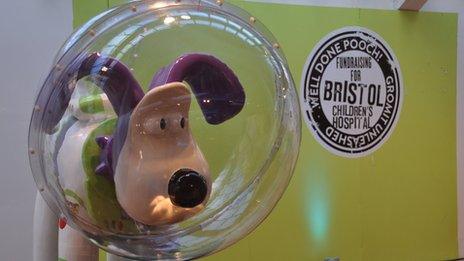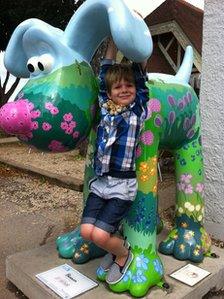Gromit statues auction raises £2.3m for Bristol Children's Hospital
- Published

The Grand Appeal hopes to fund state-of-the-art equipment for Bristol Children's Hospital
More than £2.3m has been raised for charity as dozens of Gromit statues were auctioned in Bristol.
All 81 of the sculptures were sold for Wallace & Gromit's Grand Appeal, which is raising £3.5m for an expansion of Bristol Royal Hospital for Children.
One lot, Gromit Lightyear, designed by animation studio Pixar and based on the Toy Story character, sold for £65,000.
Nick Park, who created the Gromit character, said he was "stunned" by how much had been raised.
'So generous'
"I couldn't wait to see the Pixar Gromit Lightyear go because obviously that was a top runner," Mr Park said.
"It just kept going up. When the first few started climbing I started tingling. It was double the target.

Gromit Lightyear sold for £65,000
"It is obviously for the children's hospital, everyone has been so generous, the people in the room, on the internet and the artists," he added.
Bidders packed into a specially erected pavilion at Bristol's Cribbs Causeway shopping centre, with almost 2,000 more taking part in the action online.
One of the unsuccessful bidders was five-year-old Thom Clarke from Fishponds.

Thom Clarke had hoped his £11.57 would be enough to buy Blossom
He wrote a letter to the "Gromit keepers" to say he had visited all of the statues over the summer and Blossom was his favourite.
"I have £11.57 saved up and I would like to bid my money on Blossom please.
"I hope I win," he said.
The Grand Appeal hopes to fund state-of-the-art equipment, family facilities and child-friendly artwork to complement a £31m investment by the NHS.
Last month a pre-auction show of the Gromit sculptures, called The Greatest Dog Show On Earth, drew crowds of about 22,000.
They had previously been displayed around the city during the summer and quickly became a popular tourist attraction.
While the majority of the sculptures were based around Bristol, there were others at London Paddington station, Westonbirt Arboretum in Gloucestershire, Cheddar Gorge in Somerset and Hawkesbury Upton, South Gloucestershire.
The trail attracted visitors from numerous countries across Europe, the Americas and Asia.
- Published4 October 2013
- Published24 September 2013
- Published21 September 2013